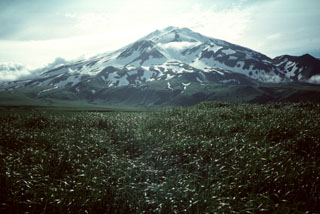Report on Seguam (United States) — May 1993
Bulletin of the Global Volcanism Network, vol. 18, no. 5 (May 1993)
Managing Editor: Edward Venzke.
Seguam (United States) Ash eruptions reported
Please cite this report as:
Global Volcanism Program, 1993. Report on Seguam (United States) (Venzke, E., ed.). Bulletin of the Global Volcanism Network, 18:5. Smithsonian Institution. https://doi.org/10.5479/si.GVP.BGVN199305-311180
Seguam
United States
52.315°N, 172.51°W; summit elev. 1054 m
All times are local (unless otherwise noted)
A small ash burst, rising through clouds near Pyre Peak, was reported by the U.S. Coast Guard on 28 May. A plume to 3 km altitude was reported on 2 June by the NWS, but it is not known if the plume contained ash.
Geological Summary. The 11.5 x 24 km island of Seguam, between Amlia and Amukta Islands in the central Aleutians, contains two calderas with Holocene post-caldera cones. Growth of the basaltic-to-rhyolitic Wilcox volcano on the east side of the island during the late Pleistocene was followed by edifice collapse and an associated ignimbrite eruption about 9,000 years ago, leaving a caldera open to the west, inside which a rhyolitic cone was constructed. The 3 x 4 km westernmost caldera has a central scoria cone, Pyre Peak, which rises above the caldera rim and is the source of most of the reported eruptions. A very young basaltic field surrounds Pyre Peak, and lava flows partially fill the caldera and reach the southern coast. Older Holocene lava flows were erupted from vents within the eastern caldera, and a monogenetic Holocene cone forms Moundhill volcano on the eastern tip of the island.
Information Contacts: AVO.

